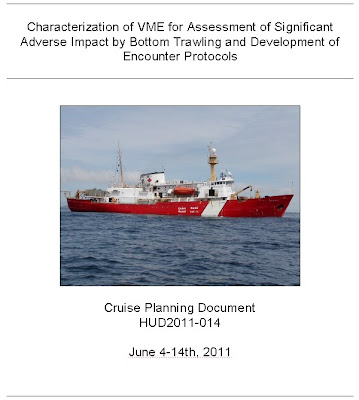 |
| Examples of seapens (Order Pennatulacea) we may see in the Laurentian Channel |
Characterization of VME for Assessment of Significant Adverse Impact by Bottom Trawling and Development of Encounter Protocols
Tuesday, May 31, 2011
Mission Plan Ready
Wednesday, May 25, 2011
ELLEN KENCHINGTON GIVES TALK AT ADM OCEANS AND SCIENCE LECTURE SERIES - MAY 12, 2011, 200 KENT STREET, OTTAWA
 |
| Dr. Ellen Kenchington |
For most people, reflection on the cold waters of the North Atlantic does not bring forth mental images of colourful corals and delicately-shaped sponges. Yet the deep waters of our continental slopes support extensive aggregations of these species that rival many of their more familiar tropical counterparts for biodiversity and structural relief. Although we have known of their existence in our waters since the 19th century, it has only been in recent years that technology has allowed us to study these organisms in their natural habitat. The 2006 UN General Assembly Resolution on Sustainable Fisheries (61/105) was instrumental in maintaining the momentum of the nascent research on deep water corals and sponges by calling for action to protect vulnerable marine ecosystems (VMEs) from the degrading effects of bottom fishing activities. Many of these species also meet several of the criteria adopted by the Convention on Biological Diversity (CBD) in 2008 to identify ecologically and biologically sensitive areas of the high seas. This seminar will highlight the fascinating biology and ecology of corals and sponges of the North Atlantic and summarize the research that DFO is undertaking in support of UNGA 61/105.
Click here for a copy of Ellen's talk.
Wednesday, May 11, 2011
HUDSON 014 2011 - MISSION MEETING MAY 10, 2011
 |
| Aerial View of the CCGS Hudson |
Thanks to everyone for your contributions to the meeting yesterday (May 10, 2011). We will take your suggestions into consideration and produce a revised mission plan by the end of the week. Please let us know by the end of the day Thursday (May 12, 2011) if you have any further suggestions and we'll try our best to incorporate it in the mission GIS project.
The mission details are still being ironed out, but a draft mission plan will be produced soon and posted on this site for further comment prior to our departure. What we do know is that the Hudson will sail from June 4th to June 14th. We will visit 3 main sites (figure below): Emerald Basin (1) where the world's largest concentration of the glass sponge Vazella pourtalesi exists, the Laurentian Channel (2) where the worlds highest concentration of sea-pens exists (order Pennatulacea), and then on to the Gully Marine Protected Area (3) to investigate a geological feature at the mouth of the canyon that, from early evidence, appears to play a role in providing suitable habitat for sea birds and northern bottlenose whales.
A pdf copy of yesterday's presentation is available here for those who wish to see it. Please visit the Sailwx website for more information on Hudson's current location. I checked this morning and her last update was Apr 22 at 1200. She's currently in the Labrador Sea and I'm hoping for our trip this link will work for family and friends to track our progress.
Please let me know of any interesting links that you think we could post on the blog.
 |
| Station Locaitons - 1 Emerald Basin; 2 Laurentian Channel; 3 Gully MPA |
Subscribe to:
Posts (Atom)
